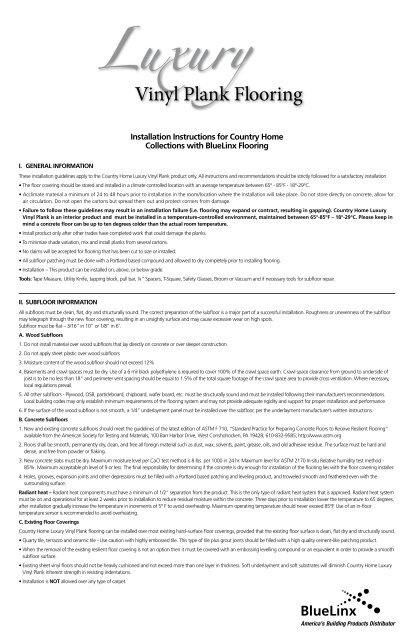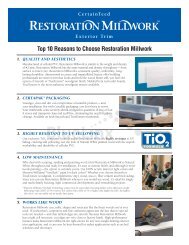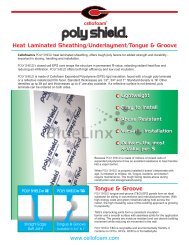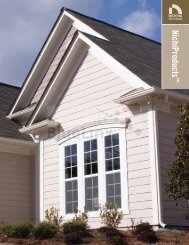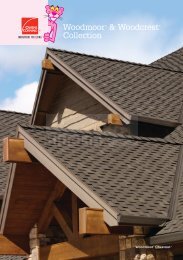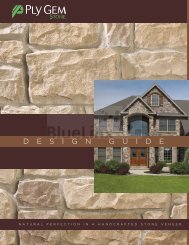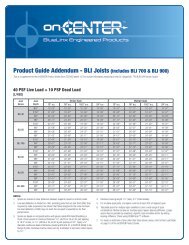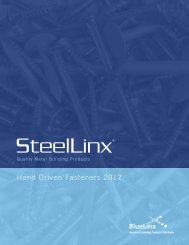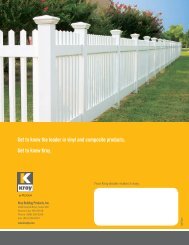Vinyl Plank Flooring - BlueLinx
Vinyl Plank Flooring - BlueLinx
Vinyl Plank Flooring - BlueLinx
You also want an ePaper? Increase the reach of your titles
YUMPU automatically turns print PDFs into web optimized ePapers that Google loves.
Luxury<br />
<strong>Vinyl</strong> <strong>Plank</strong> <strong>Flooring</strong><br />
Installation Instructions for Country Home<br />
Collections with <strong>BlueLinx</strong> <strong>Flooring</strong><br />
I. GENERAL INFORMATION<br />
These installation guidelines apply to the Country Home Luxury <strong>Vinyl</strong> <strong>Plank</strong> product only. All instructions and recommendations should be strictly followed for a satisfactory installation.<br />
• The floor covering should be stored and installed in a climate controlled location with an average temperature between 65° - 85°F - 18°-29°C.<br />
• Acclimate material a minimum of 24 to 48 hours prior to installation in the room/location where the installation will take place. Do not store directly on concrete, allow for<br />
air circulation. Do not open the cartons but spread them out and protect corners from damage.<br />
• Failure to follow these guidelines may result in an installation failure (i.e. flooring may expand or contract, resulting in gapping). Country Home Luxury<br />
<strong>Vinyl</strong> <strong>Plank</strong> is an interior product and must be installed in a temperature-controlled environment, maintained between 65°-85°F – 18°-29°C. Please keep in<br />
mind a concrete floor can be up to ten degrees colder than the actual room temperature.<br />
• Install product only after other trades have completed work that could damage the planks.<br />
• To minimize shade variation, mix and install planks from several cartons.<br />
• No claims will be accepted for flooring that has been cut to size or installed.<br />
• All subfloor patching must be done with a Portland based compound and allowed to dry completely prior to installing flooring.<br />
• Installation – This product can be installed on, above, or below grade.<br />
Tools: Tape Measure, Utility Knife, tapping block, pull bar, ¼” Spacers, T-Square, Safety Glasses, Broom or Vacuum and if necessary tools for subfloor repair.<br />
II. SUBFLOOR INFORMATION<br />
All subfloors must be clean, flat, dry and structurally sound. The correct preparation of the subfloor is a major part of a successful installation. Roughness or unevenness of the subfloor<br />
may telegraph through the new floor covering, resulting in an unsightly surface and may cause excessive wear on high spots.<br />
Subfloor must be flat – 3/16” in 10” or 1/8” in 6’.<br />
A. Wood Subfloors<br />
1. Do not install material over wood subfloors that lay directly on concrete or over sleeper construction.<br />
2. Do not apply sheet plastic over wood subfloors<br />
3. Moisture content of the wood subfloor should not exceed 12%<br />
4. Basements and crawl spaces must be dry. Use of a 6 mil black polyethylene is required to cover 100% of the crawl space earth. Crawl space clearance from ground to underside of<br />
joist is to be no less than 18” and perimeter vent spacing should be equal to 1.5% of the total square footage of the crawl space area to provide cross ventilation. Where necessary,<br />
local regulations prevail.<br />
5. All other subfloors - Plywood, OSB, particleboard, chipboard, wafer board, etc. must be structurally sound and must be installed following their manufacturer’s recommendations.<br />
Local building codes may only establish minimum requirements of the flooring system and may not provide adequate rigidity and support for proper installation and performance.<br />
6. If the surface of the wood subfloor is not smooth, a 1/4” underlayment panel must be installed over the subfloor, per the underlayment manufacturer’s written instructions.<br />
B. Concrete Subfloors<br />
1. New and existing concrete subfloors should meet the guidelines of the latest edition of ASTM F 710, “Standard Practice for Preparing Concrete Floors to Receive Resilient <strong>Flooring</strong>”<br />
available from the American Society for Testing and Materials, 100 Barr Harbor Drive, West Conshohocken, PA 19428; 610-832-9585; http://www.astm.org<br />
2. Floors shall be smooth, permanently dry, clean, and free all foreign material such as dust, wax, solvents, paint, grease, oils, and old adhesive residue. The surface must be hard and<br />
dense, and free from powder or flaking.<br />
3. New concrete slabs must be dry. Maximum moisture level per CaCl test method is 8 lbs. per 1000 in 24 hr. Maximum level for ASTM 2170 In-situ Relative humidity test method -<br />
85%. Maximum acceptable ph level of 9 or less. The final responsibility for determining if the concrete is dry enough for installation of the flooring lies with the floor covering installer.<br />
4. Holes, grooves, expansion joints and other depressions must be filled with a Portland based patching and leveling product, and troweled smooth and feathered even with the<br />
surrounding surface.<br />
Radiant heat – Radiant heat components must have a minimum of 1/2” separation from the product. This is the only type of radiant heat system that is approved. Radiant heat system<br />
must be on and operational for at least 2 weeks prior to installation to reduce residual moisture within the concrete. Three days prior to installation lower the temperature to 65 degrees,<br />
after installation gradually increase the temperature in increments of 5° F to avoid overheating. Maximum operating temperature should never exceed 85°F. Use of an in-floor<br />
temperature sensor is recommended to avoid overheating.<br />
C. Existing Floor Coverings<br />
Country Home Luxury <strong>Vinyl</strong> <strong>Plank</strong> flooring can be installed over most existing hard–surface floor coverings, provided that the existing floor surface is clean, flat dry and structurally sound.<br />
• Quarry tile, terrazzo and ceramic tile - Use caution with highly embossed tile. This type of tile plus grout joints should be filled with a high quality cement-like patching product.<br />
• When the removal of the existing resilient floor covering is not an option then it must be covered with an embossing levelling compound or an equivalent in order to provide a smooth<br />
subfloor surface.<br />
• Existing sheet vinyl floors should not be heavily cushioned and not exceed more than one layer in thickness. Soft underlayment and soft substrates will diminish Country Home Luxury<br />
<strong>Vinyl</strong> <strong>Plank</strong> inherent strength in resisting indentations.<br />
• Installation is NOT allowed over any type of carpet.
III. INSTALLATION<br />
Country Home Luxury <strong>Vinyl</strong> <strong>Plank</strong> flooring is designed to be installed utilizing the floating method only. Never secure the planks to the subfloor. Undercut all doorjambs. Do not fasten<br />
wall mouldings and or transition strips to the planks.<br />
1. Before you start with the installation, it is important to determine the layout of the flooring. Proper planning and layout will prevent having narrow plank widths at wall junctures or<br />
very short length pieces at the end of rows.<br />
2. As with all plank products, install the planks parallel to the longest exterior wall.<br />
3. Determine if the starter row will need to be cut. If the first row of planks does not need to be trimmed in width, it will be necessary to cut off the unsupported tongue so that a clean,<br />
solid edge shows towards the wall.<br />
4. Installation of the product must start from the left side of the room, working to the<br />
right when working in front of the planks or facing the starting wall. (See Fig. 1)<br />
5. Install the second plank in the row by angling the end tongue into the end groove<br />
of the first plank. (See Fig. 2) Be careful not to bend the corner of the plank.<br />
Maintain an expansion gap of approximately 5/16”– 8mm from the wall.<br />
(See Fig. 3) Start the second row by cutting a plank to the desired length. Keep in<br />
mind that the plank must not be shorter than 6 inches – 15cm to receive the best looking appearance.<br />
6. Install the first plank in the second row by inserting the long side tongue into the groove of the plank in the first row.<br />
(See Fig. 4) This is best done with a low angle of the plank. Maintain pressure into the side seam as you rotate<br />
the plank to the subfloor. Install the second plank in the second row by inserting the short end tongue into the<br />
previously installed plank groove. Align the plank so that the long side tongue tip is positioned just over the groove<br />
lip of the plank in the first row. Working from the end seam, at a low angle, insert the long tongue into the groove<br />
of the adjoining plank. Very little force is required to seat the tongue into the groove. You should feel the tongue lock<br />
into the groove. (See Fig. 5)<br />
7. Work across the length of the room installing planks along the wall in the first row and then aligning the planks in the second row. It is critical to<br />
keep these two rows straight and square, as they are the “foundation” for the rest of the installation. Check squareness and straightness often.<br />
(See Fig. 6)<br />
8. Cut the last plank in the first row and leave an expansion gap of around 5/16” - 8mm. <strong>Plank</strong>s may be cut with a utility knife using the “score<br />
and snap” technique. The leftover of this plank may be used to start the third row if it’s a minimum 6” – 15cm long.<br />
9. Continue installing planks and make sure to achieve a random appearance with end pieces of minimum 6” – 15cm. Check that all planks are fully<br />
engaged; if a slight gapping is found, the gap can be tapped together by using a tapping block and a scrap of flooring to cover the tapping block<br />
in order to avoid damages on the planks.<br />
10. When fitting under door casings, etc, the flexibility and convenient connection of Valigne Locking System becomes evident. If necessary, a flat<br />
pull bar may be used to assist in locking the planks. (See Fig. 7)<br />
11. When fitting around obstacles or into irregular spaces, planks can be cut easily and cleanly using a utility knife with a sharp blade. It is often<br />
beneficial to make a cardboard template of the area and transfer this pattern to the plank. (See Fig. 8 & 9)<br />
12. Protect all exposed edges of the flooring by installing wall moulding and/or transition strips. Make sure that no<br />
plank will be secured in any way to the sub floor.<br />
13. Protect the finished flooring from exposure to direct sunlight.<br />
Fig. 1 Fig. 2 Fig. 3<br />
Fig. 4<br />
>2xW<br />
W<br />
Fig. 5<br />
Fig. 6<br />
Fig. 7<br />
Fig. 8<br />
Fig. 9<br />
IV. REPAIRS<br />
Country Home Luxury <strong>Vinyl</strong> <strong>Plank</strong> flooring is tough and durable; however, if a plank becomes damaged, it can be replaced. If the damaged plank is along the perimeter of the room, the<br />
easiest technique is to disconnect the planks until the damaged plank is removed. Replace the plank and reassemble the planks. If it is impractical to disconnect and reassemble the flooring,<br />
the following procedure should be followed:<br />
• Using a straight edge and a sharp utility knife, cut out and remove the center of the damaged plank, leaving approximately 1” – 2.5cm strip attached to the surrounding planks on all<br />
sides.<br />
• Carefully cut back from the corners of the plank to the inside edge.<br />
• Remove the plank edges by wiggling the cut plank out from the tongue and groove of the surrounding planks.<br />
• Prepare the replacement plank by placing the plank face down and folding back and removing the groove strip on both the long and end profile. Using the decorative surface of the<br />
tongue end as a guide cut away this overhanging profile using a sharp utility knife.<br />
• Place some moisture resistant tape onto the subfloor covering sufficient area of the removed plank and underneath the adjoining planks.<br />
• Position the replacement plank by engaging the tongue of the long side into the groove of the adjoining plank. “Hinge” the prepared replacement plank into position and press in the<br />
tape.<br />
• Use a hand roller to assist in aligning the plank edges into position and to help secure the plank into the tape adhesive.<br />
CAUTION: Some types of nails, such as common steel nails, may cause discoloration of the vinyl floor covering. Recommendations for attaching underlayment panels are not included.<br />
Solvent based construction adhesives are known to stain vinyl floor coverings. All responsibility for discoloration problems caused by the use of the above mentioned products is not the<br />
responsibility of <strong>BlueLinx</strong>, but rests with the installer and the underlayment panel manufacture.<br />
V. MAINTENANCE<br />
Use walk-off mats at each entrance to prevent dirt, sand, grit and other substances from being tracked onto your floor. Use non-staining mats on your floor. Do not put rubber-backed,<br />
latex-backed or coco fiber mats on your floor. Possible staining or damage the surface can occur.<br />
Close your curtains or blinds where extreme sunlight hits the floor. A combination of heat and sunlight causes most home furnishings to fade or discolour.<br />
Support furniture with wide-bearing, non-staining floor protectors. Ideally, the protectors should be at least one inch in diameter, made of non-pigmented hard plastic, and rest flat on<br />
the floor. Non-staining felt protectors are also acceptable. Casters (type W), felt pads or floor protectors are recommended for all moveable furniture. Use protection mats under chairs<br />
with caster in order to avoid abrasion of the vinyl flooring. Make sure that any metal protectors are rust-proof.<br />
If you need to move heavy furniture and/or appliances across the floor, always use strips of wood or hardboard runways to protect the floor. Always use runways even if you have an<br />
appliance dolly, or even if the heavy objects are equipped with wheels or rollers.<br />
Sweep your floor regularly and clean with a damp cloth and water at least once a week.<br />
Prevent stains by wiping up spills promptly. Occasional damp mopping with a Rinse-Free Cleaner or<br />
similar product is recommended when dirt builds up and sweeping alone is not sufficient. Strictly follow the mixing recommendations of the cleaner used. Do not use soap or detergent<br />
products as they will leave a dulling film.


